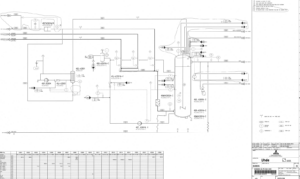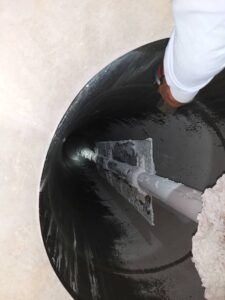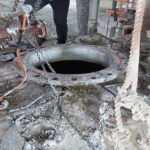Introduction
Arvand petrochemical PVC reactor optimization project was started with the aim of improving reactor performance and improving the quality of the final product. This project included various stages including detailed reactor modeling, hydraulic and thermal behavior analysis, process simulation in advanced software, and implementation of optimization changes.
To achieve the desired results, 3D modeling was performed using COMSOL Multiphysics V5.6 software, and process simulation in ASPEN POLYMER helped to examine process details and identify optimization opportunities. The ultimate goal of this project was to improve reactor performance by identifying and solving technical problems, increasing product efficiency and quality, and economic evaluation in order to improve the overall economic performance of the project.
Reactor Study and Modeling
Preliminary Checks and Identification of Problems
In the first step of the project, the focus was on checking the performance of the reactor and identifying existing technical problems. These studies were performed using COMSOL Multiphysics V5.6 software. which provides the possibility of accurate and comprehensive modeling of the reactor along with all related components, including stirrer and propellers. The main goal of this stage was to deeply analyze the hydraulic and thermal behavior of the reactor in order to identify weak points and functional problems.
The three-dimensional modeling of the reactor was done carefully considering all the design details,. including the dimensions and geometric shape of the stirrer and propeller. This modeling allowed us to comprehensively and accurately examine the state of the reactor. and to identify problems related to dead flows and fluid stagnation points. Also, we were able to identify areas that had poor heat transfer and where the temperature distribution was incorrect.
Analysis of Hydraulic and Thermal Behavior
At this stage, the focus was on analyzing the hydraulic and thermal behavior of the reactor. For this purpose, the simulated model includes all critical parameters including velocity fields. The distribution of component concentration, pressure, and temperature was throughout the reactor. This analysis helped us identify areas with dead flows, stagnation points, and areas with poor heat transfer.
One of the main goals of this analysis was to examine the details of the stirrer design and how it interacts with the fluid. The design of the stirrer and its operation have a direct effect on the uniform distribution of temperature and concentration of components in the reactor. The results of the analysis showed that in some parts of the reactor, there are fluid retention points. which reduces the efficiency and quality of the product due to the insufficient design of the stirrer and the lack of uniform temperature distribution.
Check The Design Details of The Mixer
In this section, a more detailed review of the stirrer design was done. The way the stirrer interacts with the fluid and its effect on the temperature distribution and concentration of the components in the reactor were specially considered. The simulation analysis showed that the stirrer design can have a significant effect on improving or reducing the uniform distribution of temperature and concentration in the reactor.
In general, this stage of modeling and analysis helped to identify the basic problems of the reactor and provide the basis for subsequent corrections and optimizations. Accurate modeling and analysis of hydraulic and thermal behavior of the reactor provided a basis for better design and optimization of reactor performance. And it allowed us to propose effective solutions to improve reactor performance.
Process Simulation in ASPEN POLYMER
Process simulation in ASPEN POLYMER is an essential part of Arvand petrochemical PVC reactor optimization project. ASPEN POLYMER is one of the advanced software in the field of simulation of polymerization processes. which provides extensive possibilities for accurate modeling of chemical processes, separation, and production of polymer products.
The use of this software in the current project allows us to conduct a comprehensive analysis of the entire PVC production process, from the input feed to the final product, and identify weaknesses and opportunities for optimization.
1. Preparation of Process Data:
To start the simulation process, we first need to collect and analyze operational data and process characteristics of the reactor and other equipment. These data include information such as feed composition, operating temperature and pressure, flow rates, and final product specifications.
Data related to cooling systems, isolation units, and other peripheral equipment should also be carefully considered. At this stage, the actual operational data are checked and matched with the required data in ASPEN POLYMER so that the simulation model can accurately reflect the real conditions of the reactor.



2. Building a Process Model:
In this step, using ASPEN POLYMER software, we create the complete process model of the PVC unit. This model includes all main and auxiliary equipment such as polymerization reactor, cooling units, separation, and product purification. Each of these devices is defined as an operational unit in the software.
Accurate modeling of the polymerization reactor as the heart of the process, including the definition of reaction kinetics, operating conditions, and the impact of various factors on reactions and product distribution, is an important part of this step. Because ASPEN POLYMER provides advanced tools for modeling polymerization reactions. We can accurately simulate the molecular weight distribution, percentage conversion of monomers, and the quality of the final product.
3. Determining Optimal Operating Conditions:
After building the process model, the software allows us to simulate different operational scenarios. In this step, the change of various parameters such as temperature, pressure, feed flow rate, and the proportions of reactant components are investigated in order to evaluate the effect of each of them on the process performance.
The purpose of these analyzes is to find optimal operating conditions. Which leads to the highest conversion rate, reducing production costs, and improving the quality of the final product. By analyzing the results of the simulations, it is possible to achieve the conditions that guarantee the optimal performance of the reactor and the process.
4. Performance Evaluation and Prediction of Results:
By completing simulation and process optimization, the final model is used as a powerful tool to predict unit performance under various operating conditions. This model allows us to evaluate the impact of changes in input feed, operating conditions, and equipment settings on overall process performance and final product quality. In addition, the simulation model is used as a decision-making tool for unit management. And it can help reduce risks and increase productivity.
Analysis of Identified Problems and Corrective Actions
During the process of simulation and performance analysis of EPVC-45R-43501 A-C reactor using COMSOL Multiphysics V5.6 software, several key problems and challenges were identified. which had significant effects on the efficiency and productivity of the reactor. This section is dedicated to the detailed analysis of these problems and providing corrective solutions to solve them.
Analysis of Identified Problems and Corrective Actions
1. Hydraulic problems: areas with inefficient fluid flow were identified and flow pattern optimization was done to increase mixing and reduce dead spots in the reactor. Changing the design of the mixer and adjusting its position and speed was one of the corrective measures.
2. Insufficient heat transfer: The reactor temperature analysis showed that there is a decrease in heat transfer due to deposits on the reactor walls. Corrective measures included changing the design of the cooling jacket and increasing the heat transfer rate.
3. Adhesion and particle coagulation phenomena: By identifying areas with the possibility of sediment formation, the design of the reactor was optimized in such a way as to prevent the formation of sediment and particle adhesion.
Visual Examples of Reactor Problems



Accurate Optimization and Simulation
More Accurate Modeling and Removal of Simplifying Assumptions
At this stage of the project, a more detailed modeling of the reactor was initiated with the aim of removing simplified assumptions and taking into account all the complex details of the process. This process involved detailed analysis of hydraulic behavior, mass transfer, and chemical reactions within the reactor to obtain a more realistic picture of the reactor’s actual performance. For this purpose, all data related to temperature and pressure distribution, velocity fields, and component concentrations were carefully examined. And new and comprehensive data were added to the model. This more detailed modeling was done using COMSOL Multiphysics V5.6 software. which was able to simulate all the real complexities of the process. and provide accurate results for the next stage of optimization.
CFD Simulation to Predict Reactor Behavior
One of the key tools at this stage was Computational Fluid Dynamics (CFD) simulation, which was used to accurately predict the behavior of the reactor. This simulation allows for a detailed investigation of velocity fields, component concentration distribution, pressure, and temperature inside the reactor.
CFD simulation helped to identify problems in temperature and velocity distribution. And the weaknesses of the reactor design will be revealed. According to the results of this simulation, the position and speed of the stirrer were optimized in order to achieve the highest conversion rate and produce more output products. Detailed analyzes showed that by improving the position of the stirrer and adjusting its speed properly, a more uniform distribution of temperature and concentration of components in the reactor can be obtained and fluid stagnation points can be reduced.
Investigating Complex Phenomena
In the final stage of the simulation, complex phenomena such as deposition on the walls, reduction of heat transfer, and adhesion and coagulation of particles were investigated. These phenomena can significantly affect the performance of the reactor and the quality of the final product.
More detailed simulations showed that fouling can lead to reduced reactor efficiency and heat transfer. Also, the phenomena of adhesion and coagulation of particles were also investigated to determine their effect on the overall performance of the reactor. With in-depth analysis, solutions were provided to improve the situation. which included improving the design and operating conditions. These measures led to the reduction of the negative effects of these phenomena and the overall improvement of the reactor performance.
This stage of detailed simulation and modeling, taking into account all the complex details and existing problems, allowed us to provide effective solutions to optimize the reactor performance and achieve a higher level of productivity and product quality.
Implementation of The Optimization Plan
Development and Evaluation of Various Plans
More detailed simulations showed that fouling can lead to reduced reactor efficiency and heat transfer. Also, the phenomena of adhesion and coagulation of particles were also investigated to determine their effect on the overall performance of the reactor. With in-depth analysis solutions were provided to improve the situation. which included improving the design and operating conditions. These measures led to the reduction of the negative effects of these phenomena and the overall improvement of the reactor performance.
In this process, different agitator designs were analyzed in detail. The design of agitators was investigated by considering criteria such as maximum efficiency of heat transfer and mass transfer, as well as preventing fluid stagnation in different parts of the reactor. In particular, the proposed changes in the position and angle of the stirrers were carefully compared to ensure that the temperature and concentration distribution was uniform throughout the reactor and fluid stagnation points were minimized.
Examining and comparing these designs allowed us to identify the best design options. Selected designs were selected based on key performance criteria and based on analysis obtained from simulations. These choices effectively affected the performance of the reactor and led to the improvement of temperature distribution and component concentration in the reactor.
Implementation of Changes and Unit Shutdown
According to the selected optimization plans, the stage of implementing changes in the reactor began. This step included shutting down the unit to apply changes in the structure and design of the reactor. Major changes included installing new stirrers, adjusting their position, and improving reactor operating conditions.
The executive team of the project, in cooperation and coordination with different departments, carried out the steps of implementing the changes carefully and based on detailed plans. Careful planning and effective management were critical at this stage to ensure that all changes were implemented correctly and on time. This phase included re-examination of the designs, final adjustments, and functional tests to ensure the compatibility and effectiveness of the changes.
During the process of implementing the changes, continuous monitoring of the project implementation and its compliance with the planned plans was carried out. This monitoring included assessing the status of the project, identifying and fixing potential problems, and ensuring compliance with safety and performance standards. The executive team carefully managed all aspects to ensure that the implemented changes led to a significant improvement in reactor performance and that the optimization goals were met.
The successful implementation of these changes and optimizations significantly helped to improve the performance of the reactor and increase the productivity of the production process. These optimizations led to increased final product quality, improved process efficiency, and reduced operating costs.
Economic Analysis and Executive Benefits
Analysis of Costs and Return on Investment
One of the most important parts of this project was to conduct an economic analysis to evaluate the costs associated with the implementation of the optimization plan. This analysis included an examination of initial investment costs, operational costs, and financial benefits resulting from improved reactor performance and reduced energy consumption. The results of this analysis showed that by optimizing the reactor design and operating conditions, operating costs will be significantly reduced and the return on investment will be made quickly.
Review of Economic Benefits
The economic benefits resulting from the implementation of the optimization plan include reducing production costs, increasing system efficiency, and improving the quality of the final product. Optimizing reactor design reduces energy consumption, reduces waste, and increases profitability. These results generally improve the project’s economy and increase the company’s competitiveness in the market.
Optimization Results and Effects
The implementation of the optimization plan led to a significant improvement in the reactor performance. The changes applied in the design of the stirrer and operating conditions made the velocity field and heat distribution in the reactor optimized. And the rate of reaction conversion will increase significantly. The conditions of the input feed to the reactor were optimized to properly manage the allowed changes in them. This made the process of producing a product with higher quality and the amount of waste to be minimized.
Conclusion
The implementation of Arvand petrochemical PVC reactor optimization project led to significant achievements in improving reactor performance and increasing process efficiency. Detailed hydraulic and thermal analyses, along with comprehensive simulations, were able to identify the main problems and provide effective solutions to improve reactor performance.
Changes in the design of the stirrer and optimization of operating conditions led to a more uniform distribution of temperature and concentration, reduction of fluid retention points, and an increase in the reaction conversion rate. Also, the economic evaluation showed that these changes lead to the reduction of production costs and the improvement of the quality of the final product. which in turn increases the company’s profitability and competitiveness. This project shows the importance of using accurate modeling and simulation in optimizing industrial processes and achieving desirable results in technical and economic fields.
Related Project
In this project, the simulation and optimization of unit 445 (degassing) of Arvand Petrochemical with the aim of effectively removing vinyl chloride monomer (VCM) from latex, has been done using Aspen Plus software and analyzed the operational parameters.
Optimizing Arvand Petrochemical PVC Reactor Using Comsol
In this project, the simulation and optimization of Arvand Petrochemical PVC reactor has been done using Comsol software and the operational parameters have been analyzed.


